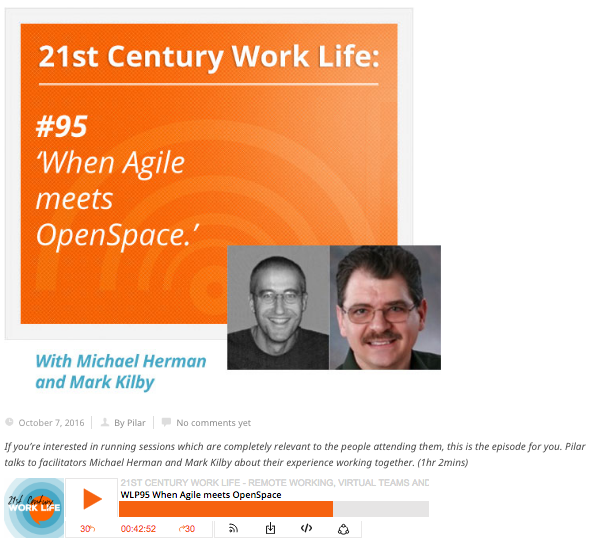Thanks to Deb Preuss and Steve Holyer to the first Agile Cocktails virtual (and international) lean coffee meetup today, where a small group of us just had a great conversation with Josh Kerievsky, CEO of Industrial Logic and one of the leading voices in the Modern Agile refactoring of the Agile Manifesto. I’ve already made a bunch of connections between Modern Agile and my own Inviting Organization work. Today’s conversation helped me make some more.
The Modern Agile story starts with Safety, on all levels, from personal to technical. Safety supports Making People Awesome or what I think of as Making People Heroes (in Awesome Stories). Awesome people are able to Learn Faster via Experimenting, which supports Delivering Value Continuously (or at least more and more often).
The FIRST challenge is moving the needle on each of these things, probably, in most cases, starting with Safety. Josh shared Stop the Process cards, the knowledge worker equivalent of Toyota’s andon cord, that team members can use in any moment or meeting when they see Safety slipping. The purpose is the same as Toyota’s legendary tool: raise awareness and make changes while the problem is still new and small.
Exploring other behaviors that reinforce Safety, we mentioned the need to keep returning to the assumption of positive intentions, that we need to find 4-5 more positives than negatives to maintain good relations, and that any targeting of self-protective withdrawal or responses will be counter-productive. Invitation, on the other hand, what we called Challenge by Choice in my teambuilding days, seems some kind of bedrock.
Now linking in some practices from pure Dialogue, developed years ago at MIT, here are some of the specific things we can invite:
- Listen… to yourself, listen to the other, listen to the center (of the team/group/circle), and listen UP (or beyond or beneath, for what might be emerging from above or below or otherwise outside of the group).
- Suspend your assumptions, especially those negative assumptions that are the basis for mistrusting behaviors. Let your assumptions be examined and questioned and adjusted separately from your Self.
- Slow the inquiry,
- Hold the Space for Difference and…
- Speak from Awareness… round out the other Dialogue principles, but were mentioned only indirect or passing way.
This reminded me that the oft-cited Cynefin framework can be wired in here, as well, on the way to articulating a SECOND, higher-level, challenge of Modern Agile. Cynefin describes four decision-making contexts:
- Simple, Obvious, Known
- Complicated, but Knowable
- Complex, Known Unknowables
- Chaotic, Unknown Unknowables
- (the cliff)
These contexts map well to the “environments” described by Emery and Trist (1965), pioneers of self-managing teams (what Emery called “purposeful and ideal-seeking systems”) and organization transformation via participative (invited!) work redesign:
- placid, random (where the goodies are just randomly available for picking)
- placid, clustered (where patterns emerge and can be known, learned, used to find more goodies)
- disturbed-reactive (competitive, where others are chasing the same goodies, with complex effects)
- turbulent (where surprises abound and success depends on adaptive learning)
- vortical (an emergent, usually unsustainable situation, think peak experience or breakdown)
The Cynefin view breaks down for me when it’s drawn as four quadrants with a kind of cliff at the far edge of chaos. In direct experience, my knowns are always a subset of what is knowable, which is then bounded by those things I can see lie just beyond my capacity to know. Which is to say they are nested wholes, like the levels in Inviting Organization Emerges. This is important, because it allows for all the levels to be true simultaneously. I know some things and don’t know what I don’t know all at once.
As life and work unfolds in each moment, one of the levels is more important than the others, but they’re all still there. AND… at each level, a different kind of Listening matters more than the others. At the most basic, I need to pay attention to my own thinking, then to others, the collective patterns, the emergent, and finally to all of them at once, swirling in a vortical way.
In the same way, the SECOND challenge of Modern Agile is to turn the four steps into a self-reinforcing virtuous practice loop is the second challenge. That takes means finding ways that continuous delivery reinforces safety and moving toward a vortical swirl that feels like doing all four at a high level and all at once. That means Inviting customers, business leaders, dev and ops into a Safe, Awesome, Fast-Learning, Continuously Valuable Dialogue. That means Inviting (vs. driving or grabbing for) more Peak Experiences and practicing the things that help us sustain higher and higher plateaus between those Peaks.
We sticky-note our way through all the knowns and knowables, toward being more and more prepared for anything and everything else, always inviting attention to whatever level of listening, knowing, decision-making and learning that is most important, in that moment and the next and the next. In this way, the being and doing of Safe, Awesome, Faster and Valuable are continuously developed and refined, same as, inseparable from the actual software product.
At the close of our session today, one of us suggested that we can’t actually make people safe. I think we can’t actually make people awesome or heroes. Or make them learn for that matter. Safe and awesome and learning are individual choices. Which is what I’ve said elsewhere about Engagement, too. The best we can do – and all we really need to do – is continually Invite them into these practices, to make it easier to choose these ways of working.

